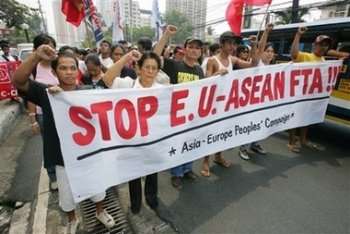Does the currency crisis in Thailand, Malaysia, Indonesia, and the Philippines spell the end of the Southeast Asian model of development?
In contrast to the path followed by the “newly industrialising countries” (NICs) in Northeast Asia, development in Southeast Asia was financed to a great extent by huge inflows of foreign investment instead of domestic savings.
Deus Ex Machina
The countries of the region were headed toward the same dire fate as that which engulfed other highly indebted countries of the South in the mid-eighties when they were retrieved from recession and spun into prosperity by what amounted to a deus ex machina: the massive inflow of Japanese direct investment. The trigger was the Plaza Accord of 1985, wherein the yen was forced to drastically appreciate relative to the dollar owing to pressure from the US, which sought to reduce its gaping trade deficit with Japan by “cheapening” its exports to that country and making its imports from Japan more expensive in dollar terms to US consumers.
With production costs in Japan rendered prohibitive by the yen revaluation, Japanese firms moved the more labor-intensive phases of their production processes to cheap-labor sites, mainly in Southeast Asia. What occurred was one of the largest and swiftest movements of capital to the developing world in recent history. One conservative estimate is that between 1985 and 1990, one conservative estimate is that some $15 billion worth of Japanese direct investment flowed into Southeast Asia. In the case of Thailand, for instance, the Japanese investment that flowed into the country in 1987 exceeded the cumulative Japanese investment for the preceding 20 years.
By 1996, about $48 billion worth of Japanese direct investment was concentrated in the core ASEAN countries of Indonesia, Singapore, Malaysia, Thailand, and the Philippines. In FY 1995, the ASEAN countries received 10.6 per cent of Japan’s total foreign direct investment, in contrast to only 7 per cent in FY 1990.
Formerly focussed mainly on raw material extraction, Japanese investment in the late eighties and early 1990’s was aimed as turning ASEAN into an integrated production base for Japanese conglomerates that assembled manufactures for export to the US, Europe, and Japan itself. And as economic growth spawned a middle class in the ASEAN countries, the region itself became an important consumer of Japanese products.
Foreign direct investment was, of course, but one channel of Japanese capital. The region was the prime recipient of Japanese aid, as well as a favoured destination of Japanese bank credit. For instance, in 1996, 40 per cent of the foreign debt of Thailand’s private sector was accounted for by loans advanced by Japanese banks.
The critical importance of Japanese investment to ASEAN was underlined in a recent report of the Japan Economic Institute: “By virtually any measure, corporate Japan’s presence in Southeast Asia is massive. Japanese affiliates employed an estimated 800,000 people across ASEAN economies in 1994, and the figure rises yearly. In a number of key industries Japanese firms have staked out a commanding regional position. Matsushita Electrical Co. Ltd’s operations alone are said to account for between 4 per cent and 5 per cent of Malaysia’s gross domestic product. Japanese manufacturers currently control about 90 per cent of the automotive market in most ASEAN countries.”
Portfolio Investors Move in
The prosperity triggered by Japanese investment was critical in turning Southeast Asia into a prime destination for global capital flows in the early 1990’s. Especially attracted were the mutual and hedge funds that tapped into the vast pool of savings and pension funds in the North and ploughed them into profitable short-term investments. With interest rates and stock prices at low levels in the United States, Japan, and other industrial markets, these funds, much of them American, were steered to “emerging markets” in search of higher returns. And with their high growth rates fuelled by Japanese investment, East and Southeast Asian countries became key magnets for speculative capital.
The attention was not only welcomed; it was cultivated. In Thailand, economic managers saw portfolio investment as a valuable supplement to Japanese direct investment to fill the gap between limited domestic savings and the massive capital investment that was required to keep the economic miracle going. At the same time, since much of these funds were American, the portfolio investment inflow would ease what until then was an overwhelming dependence on the Japanese.
For the Philippines, which had missed out on the vast movement of Japanese capital into Southeast Asia in the late eighties owing to its political instability, portfolio investment inflows, mainly from the US, were seen as the engine that would allow it to catch up with neighbours that had been launched into high-speed growth by Japanese investment.
In varying degrees, most Southeast Asian governments adopted policies to attract portfolio investment or what some writers termed “hot capital.” Three measures, in particular, were put in place:
First, foreign exchange restrictions were abolished or eased, stock exchanges were opened to foreign investors, and foreign banks were attracted with more liberal lending rules, including allowing making dollar loans to local borrowers.
Second, interest rates were kept high–higher than comparative benchmarks like US interest rates–in order to suck in foreign capital.
Third, the local currency, while not formally fixed to a particular rate of exchange, was informally pegged to a stable rate of exchange to the dollar via periodic interventions in the foreign exchange market by the central monetary authority. This was to eliminate or reduce currency risk for both foreign investors and local borrowers.
Net portfolio investments to the region rose from an annual average of $1 billion in 1985-89 to $4 billion in 1993, according to the Asian Development Bank. The figure had gone considerably higher by 1996, with Philippines alone drawing in $9.4 billion worth of foreign capital, some 75 to 80 per cent of which was portfolio investment. Thailand’s Bangkok International Banking Facility attracted over $50 billion in just three years’ time.
Foreign Investors Fuel the Real Estate Crisis
It soon became clear, however, that portfolio investment was not an unmixed blessing. They were, for one, extremely volatile, coming in one day, leaving the next, as it were, in search of higher return elsewhere. As the managing director of the Philippine Central Bank put it, in an era of globalised markets brought about by financial liberalization, billions of dollars worth of funds can be moved across the globe “at the tap of a finger.”
Also, these funds zeroed in on those parts of the domestic economy that promised a high rate of return with a quick turnaround time, and invariably, from Bangkok to Kuala Lumpur, this was the real estate sector. Manufacturing and agriculture were dismissed as low-yield sectors, where decent rates of return to capital could, moreover, be achieved only with significant amounts of investment over the long term. Mutual fund shareholders and hedge fund bondholders could not wait that long.
Not surprisingly, the property sector soon became overheated in Bangkok, Manila, and Kuala Lumpur. By 1995, the inevitable glut came to Bangkok, with the consequent domino effect of developers with unsold spanking new residential and commercial units dragging their financiers into bankruptcy with their non-performing loans. With similar gluts expected to develop in Manila, Kuala Lumpur, and elsewhere, portfolio investors began to grow skittish and withdraw their capital from these markets, resulting in plunges in stock market indicators throughout the region.
It was this growing lack of confidence among foreign investors that created the climate for the recent speculative attacks on the Thai baht, the Philippine peso, the Malaysian ringgit, and the Indonesian rupiah. A currency is only as strong as the “fundamentals” of the economy, as investors say, and with their widening current account deficits, anaemic local manufacturing sectors, troubled or stagnant agricultural sectors, and overheated real estate sectors, the fundamentals of most of the ASEAN countries are starting to look bad.
The Decline of Asian Capital Markets
Portfolio investment inflows into Thailand are drying up, and though probably not as drastically, inflows into Malaysia, the Philippines, and Indonesia are also expected to decline. The new darling of the fund managers are Latin American markets, which rose almost 40 per cent on average this year as Asian markets fell by five per cent. As the Financial Times points out, Brazilian equities, which have risen 70 per cent since the end of the year, look very good to fund managers. So do Russian equities, which have more than doubled since the start of this year, and Chinese “red chips,” which have gone up by 90 per cent. It might be sometime before the investment analysts encourage their customers to go “overweight” in Southeast Asian bonds and equities.
Japan’s Strengthened Position
Will foreign direct investors now follow portfolio investors in drawing down their presence in the region? With the slow growth in the region’s exports and the spread of deflationary tendencies, new foreign investors are likely to be deterred from making new commitments.
Ford and GM, for instance, are now probably regretting their decisions last year to invest in major car assembly plants in Thailand, based as they were on erroneous judgments that the automobile markets in that country and the rest of region would continue to grow at a torrid pace. In the case of Thailand, the projection that it would be the world’s fourth largest market for cars was based on the expansion of consumer credit. With the credit crunch, however, cars are not being sold; they are being repossessed from insolvent buyers by finance companies that are also facing bankruptcy.
But while these conditions may scare off prospective American and European investors, they are likely to have much less impact on the Japanese, who are far ahead of their American competitors in making the region an integrated production base. In Thailand alone, more than 1,100 Japanese companies are well ensconced and only a massive economic downturn can reverse the momentum which has built up. As one Japanese executive told The Nation, “It [Japanese investment] is a long term investment strategy where investments are increased on a year-to-year basis, so I don’t think a 10 to 20 per cent de facto devaluation will force Japanese investors to change their investment strategies for Thailand.”
Indeed, with most of their production aimed at other markets, a decline in local demand owing to an economic downturn will not have too big of an impact on the profitability of Japanese firms. In fact, it may well work to their advantage by dampening the pressures for wage raises. At the same time, with the assets of many Thai companies being downgraded by devaluation and debt, Japanese investors may take advantage of the current crisis to buy a controlling interest in local firms and extend their reach into the local manufacturing sector.
In sum, though the financial crisis sweeping ASEAN may well mark the end of the Southeast Asian miracle, its long term result may be a strengthening of the already dominant position of Japanese capital in the region.
*Walden Bello is co-director of Focus on the Global South, a program of policy research of Chulalongkorn University in Bangkok, and a professor of sociology and public administration at the University of the Philippines. He is the author of several books on Asian development. He is currently a book on Thailand’s economic development, A Siamese Paradox: Development and Degradation in Modern Thailand.








